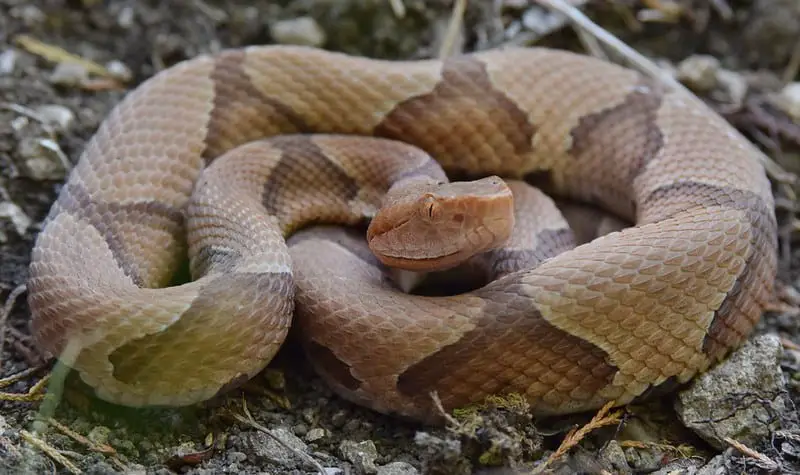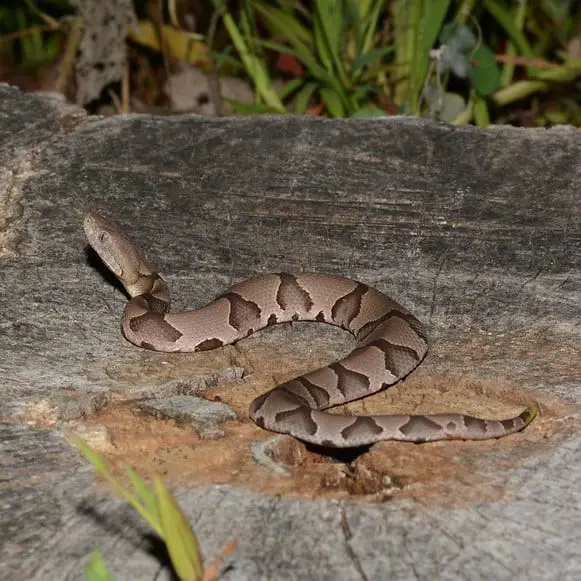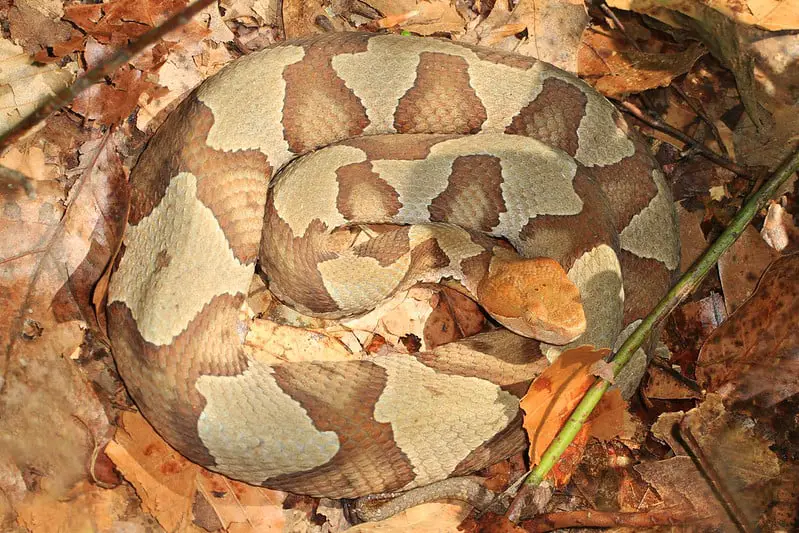The copperhead snake, Agkistrodon contortrix, is a venomous snake that can be found throughout the Eastern United States. It grows to an average size of 2-3 feet (60-90 cm). Its body is usually a light brown with several darker, copper-colored crossbands around its body.
Description
The body of the copperhead usually has an ochre-colored basic coloration and is covered with several thick copper red crossbands. The edges of the crossbands have a darker color and are surrounded by a white hue.

Its head is triangular-shaped and often has a slightly more orange or coppery coloration than the rest of its body. Hence the common name copperhead. A thin white stripe runs from the eyes to the corner of the mouth. Its loreal pits are conspicuous features. These are located between the eyes and the nasal opening and are clearly visible. Loreal pits are organs, with which pit vipers (Crotalinae) can perceive temperature differences.
In Texas, Oklahoma and Kansas, the range of the copperhead overlaps with the similar-looking and closely related broad-banded copperhead snake. It is also often confused with the venomous cottonmouth and the nonvenomous common water snake.
Size
The copperhead reaches a length of about 2-3 feet (60-90 cm) in rare cases even up to 4 feet (120 cm). Males are usually larger than females. The average weight of a female copperhead is 4 ounces (115 g) and the average weight of an adult male is around 7 ounces (200 g). The largest ever recorded copperhead snake 53.0 inches (134.6 cm) long.

Hunting Behavior
The North American copperhead eats anything it can overpower. Its diet spectrum ranges from small mammals such as mice and rats, to birds, reptiles, amphibians and insects. The tail tip of younger copperheads is often strikingly turquoise-green in color and is used as an imitation worm to attract birds or small reptiles.
The copperhead displays two hunting behaviors. Mostly, it lies in ambush on minor elevations such as fallen tree trunks waiting for bypassing prey. Its body coloration provides the perfect disguise in the forest ground. As soon as the prey is close enough, the snake will strike it with a powerful and venomous bite. After that, it will follow the wounded prey until it is immobilized by the venom and digest it as a whole.

In addition, copperhead snakes also actively chase and hunt smaller reptiles. This hunting behavior is quite unique among larger venomous snakes.
Bite
The venom of the copperhead, a haemotoxin of medium strength, is very painful but usually not fatal for an adult. Symptoms range from local pain to nausea and vomiting.
In contrast to many other snakes, the copperhead does usually not run off if a larger threat (such as humans) approach it. Its defense mechanism is to freeze and wait for the threat to pass. Due to its perfect camouflage, they are very hard to spot on the forest ground. Therefore, bites often happen when humans accidentally step on the snake.
Because of its toxicity, copperhead is used in the Appalachian Mountains for the ritual of snake touching, which is practiced by a few American Pentecostal churches.
Habitat
Copperhead snakes feel most comfortable in covered forest areas where they can use their body coloration to hide among fallen leaves or clay. Their natural hiding places are in earth caves, grassy fields, tree stumps and cairns.
Depending on its location, the snake hibernates between four and six months during the colder winter months.
Copperhead range in the USA
In the United States, the copperhead snake can be found in the following states: Alabama, Arkansas, Connecticut, Delaware, Northern Florida, Georgia, Illinois, Indiana, Iowa, Kansas, Kentucky, Louisiana, Maryland, Massachusetts, Mississippi, Missouri, Nebraska, New Jersey, New York, North Carolina, Ohio, Oklahoma, Pennsylvania, South Carolina, Tennessee, Texas, Virginia and West Virginia.
Scientific classification of Agkistrodon contortrix
- Kingdom: Animalia
- Phylum: Chordata
- Class: Reptilia
- Order: Squamata
- Suborder: Serpentes
- Family: Viperidae
- Genus: Agkistrodon
- Species: Agkistrodon contortrix
Other common names
Next to its most common name copperhead snake, Agkistrodon contortrix is also called chunk head, highland or dry-land moccasin, narrow-banded copperhead, poplar leaf, red oak, red snake, pilot snake, white oak snake or North American copperhead. In the past, several subspecies of the copperhead have been distinguished. However, this has been changed and now no subspecies are recognized. However, several old, regional common names are still used: Southern copperhead, eastern copperhead, northern copperhead, southeastern copperhead. These all describe the same snake species.